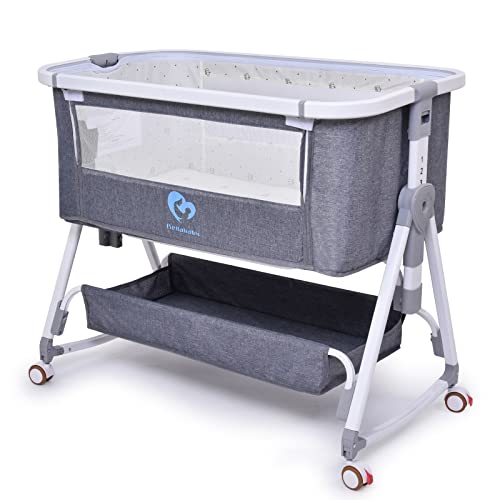Understanding Co-Sleeper Cribs: A Comprehensive Guide for New Parents
In the ever-evolving landscape of infant sleep options, co-sleeper cribs have actually amassed substantial attention among new parents. These specialized cribs offer an unique bridge in between co-sleeping and safe sleep practices, supplying advantages that resonate with both caretakers and infants. This article dives into the intricacies of co-sleeper cribs, detailing their functions, benefits, factors to consider, and responding to typical concerns to guide parents in making a notified choice.
What is a Co-Sleeper Crib?
A co-sleeper crib, also known as a bedside sleeper, is a type of crib created to securely attach or sit beside an adult bed. It permits infants to sleep near their parents without the dangers traditionally connected with adult bed-sharing. These cribs are available in numerous designs, but the majority of share an essential feature: one side that is lower, making it possible for easy reach to the baby while keeping them in their own designated sleeping space.
Key Features of Co-Sleeper Cribs
- Safe Attachment: Designed to firmly connect to the adult bed, ensuring stability.
- Adjustable Height: Height modification choices for smooth placing beside the adult mattress.
- Breathable Mesh Sides: Often geared up with breathable mesh sides to enhance air flow.
- Compact Design: Takes up less space than traditional cribs, making them perfect for small rooms.
- Portable Options: Many co-sleeper cribs are light-weight or collapsible, permitting for easy movement and travel.
Benefits of Using a Co-Sleeper Crib
Co-sleeper cribs present numerous advantages that interest new parents, including:
- Enhanced Bonding: Proximity promotes bonding and can ease nighttime feedings and comforting.
- Streamlined Nighttime Feeding: Parents can easily feed or soothe their baby without requiring to get out of bed.
- Decreased Risk of Bed-Sharing Hazards: Co-sleepers develop a more secure environment than traditional bed-sharing, lowering the risk of suffocation and falls.
- Support of Independent Sleep: Infants have their own sleep space, which promotes independent sleeping practices.
Considerations When Choosing a Co-Sleeper Crib
While co-sleeper cribs offer lots of benefits, there are also several considerations that parents must assess before buying:
- Safety Standards: Always ensure that the crib complies with present security policies supplied by companies such as the Consumer Product Safety Commission (CPSC).
- Size Compatibility: Measure the adult bed to guarantee the co-sleeper will fit safely and conveniently alongside it.
- Reduce of Use: Look for models that help with easy operation and availability, especially throughout nighttime.
- Convertible Options: Some co-sleepers use the versatility to convert into a conventional crib once the child outgrows them, which can be a cost-efficient choice.
Leading Co-Sleeper Cribs on the marketplace
To assist navigate the abundance of choices readily available, here's a table showcasing some popular co-sleeper cribs together with their standout functions:
| Brand | Model | Functions | Cost Range |
|---|---|---|---|
| Arm's Reach | Suitable Arc Crib | Adjustable height, detachable side | ₤ 150 - ₤ 230 |
| Babybay | Original Co-Sleeper | Made from sustainable wood, includes bed mattress | ₤ 240 - ₤ 300 |
| Chicco | Next2Me Magic | Easy side access, collapsible design | ₤ 200 - ₤ 280 |
| Cuddle Me | Organic Co-Sleeper | Soft, comfortable contours; portable | ₤ 120 - ₤ 180 |
| HALO | BassiNest | 360-degree rotating, height-adjustable | ₤ 250 - ₤ 350 |
Tips for Using a Co-Sleeper Crib
- Positioning: Place the co-sleeper next to the bed at the same height level for safety.
- Follow Safe Sleep Practices: Ensure the crib is set up according to guidelines to minimize threats. This consists of avoiding loose bedding and keeping the bed mattress company.
- Frequently Check Security: Periodically check the attachment in between the co-sleeper and the adult bed to guarantee it stays safe and secure and steady.
Often Asked Questions (FAQs)
1. Are co-sleeper cribs safe?Yes, when
used according to the producer's directions and safety guidelines, co-sleeper cribs are thought about a safe alternative to conventional bed-sharing.
2. How long can my baby use a co-sleeper crib?Most co-sleeper cribs are designed for infants approximately 5-6 months old, but inspect private item specs for age and weight limits. 3. Do co-sleeper cribs include mattresses?Many co-sleeper cribs come with included bed mattress, but confirm this before purchase. Guarantee any extra mattress fulfills safety requirements. 4. Can a co-sleeper crib be utilized for twins?There are co-sleeper cribs created for twins, however these models may be less common. Always check the size and weight limitations. 5. Ought to I use a co-sleeper crib for naps? my homepage ! Co-sleepers work well for both nighttime sleeping and naps, offering a consistent sleep environment for infants. Co-sleeper cribs offer an effective and safe compromise
for new parents excited to keep their infant close while preserving a safe sleeping environment. By comprehending their features, advantages, and
security considerations, parents can make informed decisions that deal with their household's requirements. Whether you're searching for benefit during nighttime feedings or a way to build a strong early bond, a co-sleeper crib may just be the right option for you and your child.

